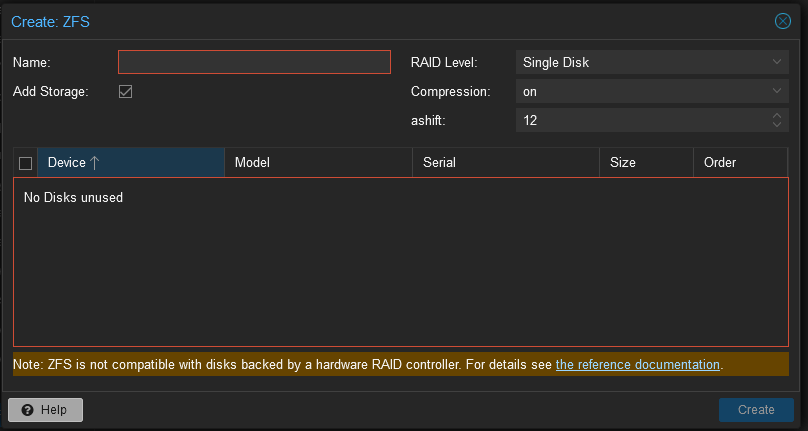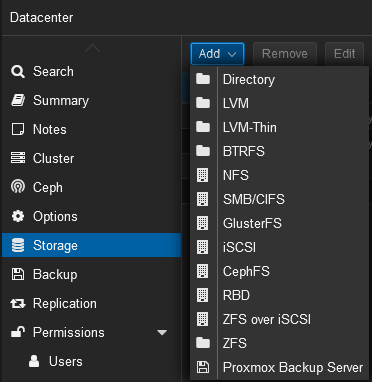Create encrypted ZFS pool on Proxmox
There are some things you can't do using the Proxmox GUI, like creating an encrypted ZFS pool. Good thing is that it's possible, you just have to bring out the CLICLI.
First of all, connect to your Proxmox host using SSH.
ssh root@proxmox.domainNow let's generate an encryption key, choose a name and location toof your liking.
dd if=/dev/random of=/root/proxmox-zfs.key bs=32 count=1Decide which drives you want to add to the ZFS pool. You can list the available drives by their Serial Number (SN) like this:
ls /dev/disk/by-id/*/dev/disk/by-id/ata-ST20000NM007D-3DJ103_XXXXXXX
/dev/disk/by-id/ata-ST20000NM007D-3DJ103_AAAAAAA
/dev/disk/by-id/ata-ST20000NM007D-3DJ103_BBBBBBBThis allows you to easily match the actual drives in your system with what you see in Proxmox. I can certainly recommend keeping track of where the drives are in your case - it helps greatly when one of them fails and you need to replace it.
What else do we want to enable on our pool? There's a couple of options we might want to add. Here's a link that will give you thesome most you would like to knowinformation - https://www.high-availability.com/docs/ZFS-Tuning-Guide/ But of course, feel free to do the research yourself.
| Property | Recommended Value | Description |
|---|---|---|
| ashift | 12 | 4KiB block size |
| atime | off | Do not update atime on file read |
| recordsize | 64KiB | Smaller record sizes for databases (match the database block size) |
| recordsize | 128Kib | Standard usage (mixture of file sizes) |
| recordsize | 1Mb | Recommended for large files |
| compression | lz4 | Set compression to use the lz4 algorithm |
| xattr | sa | Store Linux attributes in inodes rather than files in hidden folders |
Here's the final command.command. Please, make sure the settings above, especially recordsize, meet your needs. WeThe candefault actuallyis set the recordsize value in Proxmox later.128Kib.
zpool create -O encryption=on -O keyformat=raw -O keylocation=file:///root/proxmox-zfs.key -o ashift
=12 -O compression=lz4 -O atime=off -O xattr=sa proxmox-zfs-cryptzfs raidz1 /dev/disk/by-id/ata-ST20000NM007D-3DJ103_XXXXXXX /dev/disk/by-id/ata-ST20000NM007D-3DJ103_AAAAAAA /dev/disk/by-id/ata-ST20000NM007D-3DJ103_BBBBBBB /dev/disk/by-id/ata-ST20000NM007D-3DJ103_CCCCCCI'm using RAIDZ1 here, which is basically RAID 5, meaning that the pool can tolerate a failure of 1 drive. You can choose other configuration that meets your needs.
You can then check the pool status
root@proxmox:~# zpool status
pool: proxmox-zfs
state: ONLINE
scan: scrub repaired 0B in 20:23:51 with 0 errors on Sun Jan 14 20:47:53 2024
config:
NAME STATE READ WRITE CKSUM
proxmox-zfs ONLINE 0 0 0
raidz1-0 ONLINE 0 0 0
ata-ST20000NM007D-3DJ103_XXXXXXX ONLINE 0 0 0
ata-ST20000NM007D-3DJ103_AAAAAAA ONLINE 0 0 0
ata-ST20000NM007D-3DJ103_BBBBBBB ONLINE 0 0 0
ata-ST20000NM007D-3DJ103_CCCCCCC ONLINE 0 0 0The pool should also now be also visible under youyour Proxmox node --> Disks --> ZFS
(yours will be empty, I already have data here)
To be able to use this pool in Proxmox for VMs or Containers, we need to create a ZFS Storage as well. Go to the Datacenter view --> Storage and click on ZFS
Here's where you can also pick the Block Size,Size, which is basicallyvolblocksize thefor aforementionedzvols. recordsize.This is better explained here:
- https://blog.zanshindojo.org/proxmox-zfs-performance/
- https://klarasystems.com/articles/tuning-recordsize-in-openzfs/
- https://ibug.io/blog/2023/10/zfs-block-size/
- You can also enable Thin provision if you'd like.
You will now see the storage under you Proxmox node and you should be able to add disks to VMs using this storage.
You can actually create multiple of these on the same underlying ZFS pool. The reason for that might be that you want to use different Block Sizes (volbocksize) for OS/Swap/Database etc.





